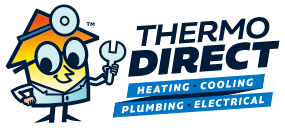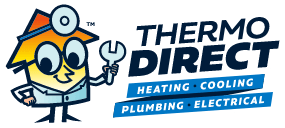In Raleigh, the cost of heating and cooling your house accounts for around 47% of your total energy bill. About half of that percentage goes toward the price of heating. As a result, upgrading to a more efficient furnace can drastically reduce your yearly heating costs. However, not every furnace works efficiently in every home. To help you choose the best heater for your home, use the 10 tips below.
1. Prioritize High Efficiency
Homeowners install new furnaces to improve indoor comfort and lower their utility bills. This is why prioritizing high efficiency is crucial to achieving both of these goals. Newer high-efficiency furnaces can reduce your fuel costs by as much as 45% when compared to homes with traditional heating systems. They are more cost-effective, quieter in operation and more conducive to a relaxing home environment.
How much efficiency does your new furnace really need? The Department of Energy mandates an Annual Fuel Utilization Efficiency (AFUE) of 80% or higher for gas furnaces. This indicates that the furnace can efficiently convert 80% of the gas into heat. A high-efficiency furnace has an AFUE rating between 94% and 98.5%. A mid-efficiency furnace achieves an AFUE rating between 90 and 93%. An Energy Star-qualified furnace must have an AFUE of 90% or above.
With all this in mind, it’s best to choose a furnace with an efficiency rating of at least 95%. If you want to take advantage of most government rebates, you’ll need a furnace with an efficiency rating of at least 96%.
2. Choose the Right Fuel Type
For optimal efficiency and savings, you need to carefully consider the new furnace’s fuel type. This requires thinking about the cost and accessibility of energy sources in and near Raleigh. Although many homeowners use gas furnaces owing to their efficiency and inexpensive running costs, their availability may vary greatly.
On the other hand, despite their low environmental impact and ease of installation, electric furnaces can become pricey in areas with high power costs. In places where natural gas is not readily available, oil and propane are two possible alternatives.
3. Size and Capacity
An improperly sized furnace can lead to extremely high heating costs as well as premature repairs and replacements. This applies to both oversized and undersized furnaces. Oversizing causes inefficiency and temperature swings due to brief cycling. Undersizing makes it impossible for the furnace to keep up with demand.
The best way to choose the right size furnace is to hire a certified technician. Taking into account the home’s square footage, insulation, windows and regional temperature, technicians can perform a Manual J load calculation to establish the proper furnace size. Technicians also look for air leaks and obstructions in the ductwork to guarantee that everything is working properly.
4. Climate and Insulation
Considering local weather patterns and the level of insulation your home has before purchasing a new furnace is crucial. This is because the number of BTUs your furnace requires to heat a space depends on the local climate. As you might expect, homes in colder areas need furnaces with higher BTU ratings than homes in warmer climates.
Having proper insulation in your home helps keep the temperature stable. This means the furnace doesn’t have to run as often, which reduces the stress placed on the unit. Adequate insulation also lessens the need to constantly adjust the heater, which further minimizes wear and tear.
5. Consider a Variable-Speed Blower
A variable-speed blower furnace has several benefits for Raleigh homeowners. Even though the area has varying weather patterns, the variable-speed function allows the furnace to adjust its heating output to maintain a constant level of comfort. In warmer weather, it runs at lower, more efficient speeds, cutting down on energy use and costs. Additionally, the slow start-up reduces uncomfortable rapid bursts of hot air, improving the quality and comfort of indoor air.
6. Air Quality Features
Assessing air quality features is paramount to choosing the right furnace. There are several ways in which your furnace affects the quality of air inside your home. First of all, if you don’t replace the filter frequently, it will recirculate dust, allergies and other pollutants throughout your house.
Second of all, without enough ventilation, a gas heater might release potentially fatal levels of carbon monoxide. Additionally, the furnace is a potential source of indoor humidity and mold growth. To avoid all of these problems, it’s best to choose a furnace with sophisticated filtration, UV germicidal lights and humidification options.
7. Consider Zoning System
Adding a zoned heating system to your home results in several advantages:
- Higher energy efficiency
- Extended furnace lifespan
- Improved indoor air quality
- Enhanced comfort
Zoned heating allows you to decide which of the rooms you want to heat, allowing you to not waste energy on heating unused spaces. You can even adjust the temperature in each room or zone to meet the preferences of individual occupants. Zoned systems also run more smoothly, reducing wear and tear on heating components and fans.
8. Maintenance Requirements
Maintenance requirements for furnaces vary from one model to the next. Electric furnaces tend to be the easiest to maintain, mostly because of their simple design. Maintenance for gas models includes regular inspections for gas leaks, ventilation assessments and cleaning the burners.
There are several parallels between propane and gas furnaces; however, propane furnaces often need additional monitoring to maintain safe combustion. No matter the type you choose, safety, efficiency and durability depend on regular expert inspections and filter changes.
9. Compatibility With Programmable Thermostat
Heat loss in Raleigh homes usually occurs because of insufficient insulation, single-pane windows, poorly sealed ductwork and thermostat misplacements. The best places to install a thermostat are in a central location on an interior wall that doesn’t fall into direct sunlight or experience drafts.
Experts agree that you can save up to 10% a year on your heating costs by installing a programmable thermostat. It’s helpful to keep it at eye level, as this helps with readability and accessibility. To avoid inaccurate readings, place the thermostat away from electronic devices and heat-generating appliances. If your home has multiple heating zones, you must use an individual thermostat in each zone.
10. Professional Installation
The most important aspect of choosing the right furnace is a professional installation. Having a trained technician onsite allows you to ensure you’re installing the right type of furnace. It also ensures the installation process maximizes the system’s efficiency instead of hurting it. The technician will perform a number of inspections, analyses, tests and calculations to guarantee higher heating efficiency, better indoor comfort and lower heating bills.
There are several other factors to consider when choosing the best furnace for your home. These include brand and manufacturer, warranty options, noise level, cost, and, of course, your budget. Thermo Direct helps homeowners in Raleigh with furnace installation. We can send a technician to inspect your home to determine the best type of system to install, followed by removing your old furnace and installing the new one. Thermo Direct also offers AC installation along with electrical and plumbing services, air quality testing and duct sealing









